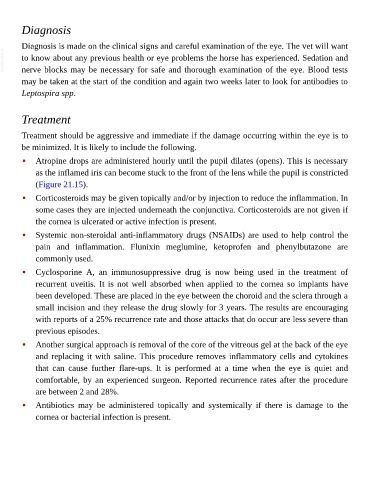Page 995 - The Veterinary Care of the Horse
P. 995
Diagnosis
Diagnosis is made on the clinical signs and careful examination of the eye. The vet will want
VetBooks.ir to know about any previous health or eye problems the horse has experienced. Sedation and
nerve blocks may be necessary for safe and thorough examination of the eye. Blood tests
may be taken at the start of the condition and again two weeks later to look for antibodies to
Leptospira spp.
Treatment
Treatment should be aggressive and immediate if the damage occurring within the eye is to
be minimized. It is likely to include the following.
• Atropine drops are administered hourly until the pupil dilates (opens). This is necessary
as the inflamed iris can become stuck to the front of the lens while the pupil is constricted
(Figure 21.15).
• Corticosteroids may be given topically and/or by injection to reduce the inflammation. In
some cases they are injected underneath the conjunctiva. Corticosteroids are not given if
the cornea is ulcerated or active infection is present.
• Systemic non-steroidal anti-inflammatory drugs (NSAIDs) are used to help control the
pain and inflammation. Flunixin meglumine, ketoprofen and phenylbutazone are
commonly used.
• Cyclosporine A, an immunosuppressive drug is now being used in the treatment of
recurrent uveitis. It is not well absorbed when applied to the cornea so implants have
been developed. These are placed in the eye between the choroid and the sclera through a
small incision and they release the drug slowly for 3 years. The results are encouraging
with reports of a 25% recurrence rate and those attacks that do occur are less severe than
previous episodes.
• Another surgical approach is removal of the core of the vitreous gel at the back of the eye
and replacing it with saline. This procedure removes inflammatory cells and cytokines
that can cause further flare-ups. It is performed at a time when the eye is quiet and
comfortable, by an experienced surgeon. Reported recurrence rates after the procedure
are between 2 and 28%.
• Antibiotics may be administered topically and systemically if there is damage to the
cornea or bacterial infection is present.

